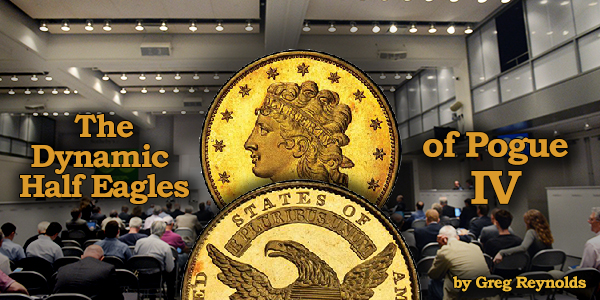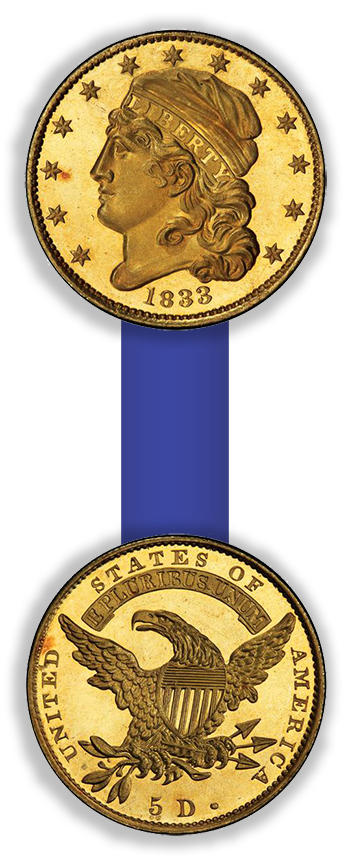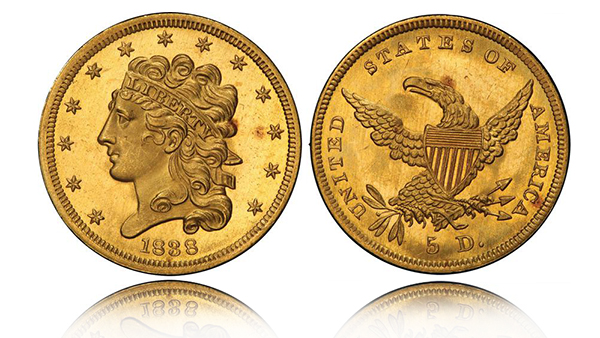
Coin Rarities & Related Topics: News and Analysis regarding scarce coins, coin markets, and the coin collecting community #334
A Weekly CoinWeek Column by Greg Reynolds …..
Last week, silver coins in the fourth auction of the Pogue Family Coin Collection were covered. The Pogue IV sale was conducted in New York city by Stack’s Bowers, in association with Sotheby’s. As this sale featured an epic offering of Capped Head and Classic Head half eagles (U.S. $5 gold coins), it would not be sensible to discuss them all here. Instead, the present focus is on the four most dynamic and glamorous half eagles in this sale: an 1821, an 1833, an 1835 and an 1838.
In Pogue IV, there was significant collector-participation for both Capped Head and Classic Head half eagles, including bidding by those acting as agents for collectors who were not physically present. In terms of the strength of prices, Classic Head half eagles tended to fare better than Capped Head half eagles. The half dollars and bust dollars discussed last week brought the strongest prices in the sale.
A few Capped Head half eagles realized weak to moderate prices. Such opportunities will be discussed at another time. The liveliest half eagles are the present topic.
Dazzling 1821 $5 Gold Coin
The Naftzger-Pogue 1821 half eagle was a pleasant surprise. It was not widely known that such a dazzling 1821 business strike exists.
The late Ted Naftzger is famous for assembling the all-time greatest collection of large cents. Few are aware that Naftzger had an incredible collection of gold coins that was sold, under the direction of David Akers, in the early 1980s.
The Naftzger-Pogue 1821 is now PCGS graded as “MS-66+” and CAC approved. The mint-caused vertical lines are cool and contribute to the astonishing manner in which this coin reflects light.
Because of some contact marks and scratches here and there, it is debatable as to whether the grade of this coin is in the middle or high end of the 66 range. Experts at CAC ignore the plus aspects of plus grades assigned by PCGS or NGC.
The issues near star #2, the gash on the face, and some of the marks on the reverse are inescapable. It may be true, however, that the overall appearance is so mesmerizing that most pertinent experts would probably overlook a few imperfections and agree with the plus aspect of the PCGS grade of “66+.” This coin does not have any problems.
Indisputably, this Naftzger-Pogue 1821 has been dipped in the 20th century. It is notably lighter in color than other half eagles and quarter eagles of similar quality from the same era. The natural dust, varying colors and crustiness that tend to characterize very original, old gold coins are not present. This coin, though, is almost alive and beams light in an almost surreal manner when it is tilted about under a lamp.
Before the auction, John Albanese remarked that it is “amazing,” and he bought this Naftzger-Pogue 1821 for $564,000, a moderate price. It is now in the CAC inventory. A weak price would have been $425,000, and $700,000 would be a fair retail price. This is a coin of tremendous importance.
The Pogue 1821 is both a Great Rarity and one of the highest quality representatives of the whole sub-type that dates from 1813 to 1829. A coin is a Great Rarity if fewer than twenty-five are known, business strikes and Proofs, including all varieties of the same ‘date,’ narrowly defined.
It is not a secret that PCGS and NGC population data includes multiple counts of many of the same coins, so estimating true populations requires careful thought and an understanding of the coin business. A working hypothesis is that there are certified, nine to twelve Capped Head half eagle business strikes that most relevant experts would grade as MS-66 or higher. With the public offering of the Pogue Family Collection, a condition ranking for the design type is now practical, though would require additional research.
The NGC graded MS-66 1821 is probably the same as this PCGS graded “MS-66+” coin. It is believed that the Pogues still have some of the printed labels (‘inserts’) from holders that housed their coins in the past.
The NGC graded MS-66 1827 half eagle has been dipped, too. This Pogue 1821 is clearly superior to that 1827. Also, the 1827 is not nearly as rare as the 1821.
In January 2014, the Goldbergs auctioned the Amon Carter 1821 half eagle for $540,500. The Carter 1821 is PCGS graded as “MS-63+” and CAC approved.
For this PCGS graded “66+” 1821, the Pogue IV catalogue estimate of $350,000 to $450,000 is puzzling. Although the Carter 1821 is not worth as much now as it was in January 2014, the Pogue 1821 should be worth more than twice as much as the Carter 1821, maybe even three times.
 PCGS and NGC together have graded just thirteen 1821 half eagles, a total that amounts to eight to eleven different coins. The 1821 is considerably rarer than the 1826, and the MS-66 grade Newcomer-Akers 1826 has been auctioned for much more than $500,000 on two different occasions over the last three years. A $750,000 result for the Pogue 1821 would not have been surprising.
PCGS and NGC together have graded just thirteen 1821 half eagles, a total that amounts to eight to eleven different coins. The 1821 is considerably rarer than the 1826, and the MS-66 grade Newcomer-Akers 1826 has been auctioned for much more than $500,000 on two different occasions over the last three years. A $750,000 result for the Pogue 1821 would not have been surprising.
Alternately, some interested collectors prefer crusty and dusty, never dipped coins that have more toning and are less dynamic than the Naftzger-Pogue 1821. Tastes and personal preferences affect auction results. Rare coins are not commodities. The collectors who viewed auction lots for this sale may have different preferences, regarding coins of the same types and grades, than pertinent coin buyers elsewhere.
Proof Capped Head $5 Coin
Although the Proof 1821 half eagle in the Smithsonian is more important in an historical sense, the Parmelee-Pittman-Pogue 1833 is the most famous Proof Capped Head half eagle. This 1833 was also owned by Waldo Newcomer, Col. Green, King Farouk of Egypt, and the anonymous collector who formed the famous gold type set that was auctioned on January 12, 2005 at the FUN Convention in Fort Lauderdale.
This 1833 was the topic of frequent conversation around the time of the Pittman I sale in October 1997. I recommended it to Jay Parrino, who wished then to pursue rare business strikes instead.
The $467,500 result in 1997 was a bit startling. This was the highest price for a single coin in the whole Pittman I event, more than four times the $110,000 result for a superb 1877 $50 pattern in copper, which was later NGC certified as “Proof-67RB.”
This 1833 was PCGS certified as Proof-67 before it was offered on January 12, 2005, in Fort Lauderdale. D. Brent Pogue then bid ‘in person’ on this coin. The $977,500 result then drew attention.
Why was the Pogue IV catalogue estimate just $850,000 to $950,000? It would have been startling if this 1833 sold for much less in May 2016 than it did in January 2005, long before markets for rare U.S. coins peaked in early August 2008.
On May 24, 2016, the Newcomer-Green-Farouk-Pittman-Pogue 1833 went for $1,351,250. This result is strong, though consistent with changes in market levels for commensurable coins over the past eighteen years.
By phone, John Albanese was the successful bidder. “I loved the coin,” John said before the auction.
The natural coppery areas and green dust are particularly appealing. This coin scores highly in the category of originality.
It is clear that this coin is not a prooflike, business strike. The die preparation was extensive and the mechanics of the impression of the dies on the planchet (prepared blank) are unlike that of corresponding business strikes. The strong mirrors and cameo contrast are important.
The texture of the surfaces is one factor that distinguishes Proofs from business strikes. The relationship between the devices (raised elements) and the fields is an equally important factor. The date is squared, a concept that relates to the shapes of the sides of design elements and the angles that they form with adjacent area of the fields. In the cases of letters, numerals and dentils, the faces (or ‘tops’) of relatively squared design elements tend to be blocklike or a little intricate on Proofs. These appear more rounded and/or less refined on business strikes.
As devices really do rise from the fields as a coin is struck, squaring can never be total; there are degrees of squaring. On business strikes, however, devices are more apt to slope into the fields. On Proofs, there is, to some extent, an optical illusion that the devices are resting on the fields, as if they were placed rather than sprang during striking. There is more discussion of these distinctions in an article on the Newman 1818 Proof quarter.
On this Parmelee-Pittman-Pogue 1833, the obverse dentils are squared, for the most part. The reverse dentils are not really squared, though are different from those found on 1833 business strikes.
While the obverse rims appear ordinary, the reverse rims were clearly formed in an especially refined manner. The letters in the legend are crisper, more elegant and further developed than those found on business strikes. The arrows are distinct and considerably squared as well. Unquestionably, this 1833 is a Gem Proof.
Proof Classic Head $5 Coin
It is fascinating that the Proof 1835 Classic Head half eagle in this sale has a pedigree that is almost the same as the just mentioned 1833. It, too, was in the Parmelee, Waldo Newcomer, Col. Green, King Farouk and John Pittman Collections, and also in the anonymous “Gold Rush” type set that was auctioned on January 12, 2005, at a FUN Convention.
 In October 1997, this same 1835 sold for $308,000. In January 2005, this Parmelee-Pittman-Pogue 1835 brought $690,000, 124% higher than the price in 1997. In contrast, the $977,500 result for the Pittman-Pogue 1833 in 2005 is 109% higher than the price realized for this 1833 in October 1997.
In October 1997, this same 1835 sold for $308,000. In January 2005, this Parmelee-Pittman-Pogue 1835 brought $690,000, 124% higher than the price in 1997. In contrast, the $977,500 result for the Pittman-Pogue 1833 in 2005 is 109% higher than the price realized for this 1833 in October 1997.
The Parmelee 1835 was PCGS certified as “Proof-67” when it was auctioned in January 2005 and it is now PCGS certified as ‘Proof-67+ Deep Cameo.’ Last week, it realized $822,500, 167% more than its auction price in 1997 and 19.2% more than this Proof 1835 sold for in January 2005.
Extreme Rarity of Proofs
Why did the Pogues not have a Proof of the first subtype of Capped Head half eagles, 1813 to 1829? There is a good chance that all ‘Large Letters’ Capped Head half eagles that are definitely Proofs are in museums.
NGC has certified an 1820 half eagle as a non-Proof Specimen, “SP-64.” I do not recall it.
The only certified Proof of the first subtype, the Garrett-Jacobson 1829 ‘Large Letters,’ was certified as a business strike for many years before being PCGS certified as a Proof not long ago. It is really a non-Proof Specimen striking, in my view.
That Garrett-Jacobson 1829 was auctioned for $1,380,000 in January 2012. Market levels were higher in 2012 than they are now. If leading bidders for relevant coins really thought that the Garrett-Jacobson 1829 was a powerful Proof, it would have brought far more than $1.38 million, as a representative of the first subtype and as a Great Rarity!
Among ‘Small Letters’ Capped Head half eagles, 1829 to 1834, NGC has certified six as Proofs. PCGS has certified two. Four to seven of these eight are different coins, and it should not be assumed that all are widely acclaimed as being true Proofs. A working hypothesis is that there are five or six, definite Proof Capped Head half eagles in private collections, portfolios or dealer inventories, including the already discussed Pogue 1833.
NGC has certified nine Classic Head fives as Proofs. PCGS has certified six. This total of fifteen amounts to maybe nine to twelve different coins. The certifications of such coins tend to change over time.
Sparkling 1838 $5 Gold Coin

Although not a Proof, the Reed-Bass-Pogue 1838 half eagle is a special coin. It is PCGS certified as “MS-65+” and CAC approved.
The obverse has the technical rating of a high end 64 grade and the whole coin has the level of eye appeal that would be associated with a grade in the middle of the 66 range. The reverse has technical characteristics on par with a grade in the middle of the 65 range. An overall grade in the high end of the 65 range follows.
There are many hairlines and very small contact marks. The overall appearance of this coin, though, is fantastic and extraordinary.
When it was auctioned in New York by Christie’s/“Spink America” during October 1996, it was the only coin in the Byron Reed Collection that was certified at all, NGC serial #615468-001. This 1838 was then in a NGC holder with a printed label that was unusual in that the word ‘Specimen’ was spelled out and the term “MS-65” was included as well. Therefore, the abbreviation for a ‘mint state’ business strike (MS) and the term for a non-Proof Special Striking, “Specimen,” were both on this one label. Collectors were curious.
When titled left or right, the obverse has fully mirrored surfaces and the head of Liberty contrasts with the fields in a semi-cameo manner. Indeed, at some angles, it is very reminiscent of a Proof. When viewed ‘straight on,’ though, business strike luster is evident, and the surface reflectivity is not thick. The reverse has more luster than the obverse.
Actually, business strikes are characterized by much luster and Proofs have minimal (if any) noticeable luster. During the striking process, metal flows in radial lines on the coin, and the lines remain, though usually cannot be seen without substantial magnification. Luster is the reflection of light by these leftovers from metal flow. Because Proofs are made differently from business strikes, such flow lines are inhibited or become too microscopic for much if any luster to be apparent to the human eye on Proofs, which are typically said to lack luster.
In total, there is not much luster on this Reed-Pogue 1838. Instead, there is an extensive assortment of die finishing lines, especially in the obverse inner fields. These are found on many other pre-1840 half eagles, including on the already mentioned 1821, but much more so on this coin. They seem to have been deliberately brought about for some kind of aesthetic effect. Some of these lines on the Reed-Pogue 1838 are similar to the die lines on 1853 half dollars that have been certified as Proofs.
The obverse rims are high and broad with wire outer rims in some parts. Such rims can be found on some business strike 1838 half eagles, so such rims do not conclusively demonstrate a point. There is no one criterion that defines a Proof or a non-Proof Specimen. There are business strikes with mirrors. If a coin is not obviously a Proof or a business strike, multiple factors must be carefully analyzed to determine its status.
Some of the design elements on this Reed-Bass-Pogue 1838 are relatively squared. Given the special nature of several design elements, the distinctive texture of the fields, the semi-cameo contrast on the obverse, the whitish glistening eagle on the reverse, the partial wire obverse rim, the presence of much less luster than usual, and the overall dynamics of this coin, it is concluded that this coin is a secondary Specimen striking.
A high-classification Specimen would be a coin that is almost a Proof or is dramatically different from business strikes for other reasons. If it takes ten minutes to determine that a coin is a Specimen, it is probably not dramatically different from relevant business strikes. This 1838 half eagle is different from business strikes, though the differences are not overwhelming.
If a corresponding frosty business strike, such as the PCGS graded MS-66 1838 that was in the “Gold Rush” type set, is placed next to this Reed-Bass-Pogue 1838, it would be apparent that the Reed-Bass-Pogue 1838 is truly different. The differences are subtle, yet the overall appearance of the coin, especially when it it tilted at various angles, is quite apart from that of business strikes, even notably distinct from very prooflike business strikes. This coin was made in a somewhat different manner.
The $164,500 auction result is extremely strong for a business strike, “MS-65+” 1838 half eagle. For $164,500, nonetheless, this coin is certainly a good value for a sophisticated collector who is not speculating and has a considerable understanding of the physical characteristics of this coin. The Reed-Bass-Pogue 1838 is a fabulous Classic Head half eagle, and one of many mind boggling coins with a Pogue pedigree.
©2016 Greg Reynolds




